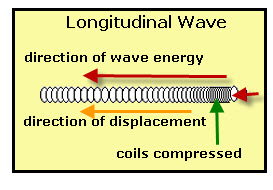 Sound is a type of energy that moves through material causing the material to vibrate. Sound is also vibrations that cause the sense of hearing.
Sound is a type of energy that moves through material causing the material to vibrate. Sound is also vibrations that cause the sense of hearing.
Vibrate means that a material moves back and forth or up and down. Sound energy causes a material to move back and forth in the same direction that the sound is traveling. Sound must have a material in order to move from one place to another. A material compresses, then spreads out as the energy moves through it. This disturbance of the material is called a wave.
Waves are disturbances in a material. Waves that cause the material to compress and spread out as the wave moves forward are called longitudinal waves. Sound energy also called sound waves, is an example of a longitudinal wave.
Model Sound Waves
A stretched Slinky can be used to model sound waves moving through a material. If some of the Slinky’s coils at one end are squeezed together, this causes the coils in front of them to spread out. When the squeezed coils are released they spread out and squeeze the coils in front of them together. The squeezed coils in turn move forward pushing on the coils in front of them and so on. Squeezing the end coils gave them energy that was transferred from one end of the slinky to the other. As the energy goes through the Slinky, all the coils do not move at once, some of the coils are crowded together and some are spread apart.